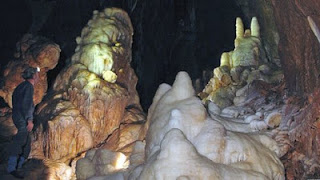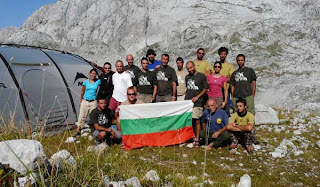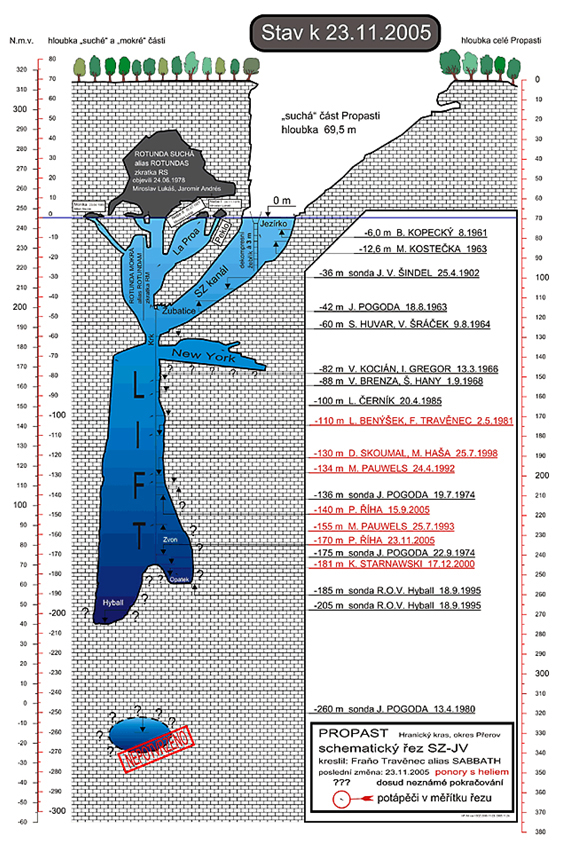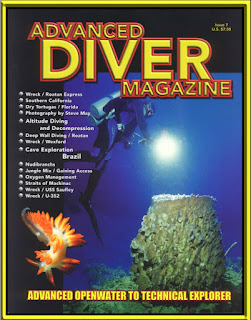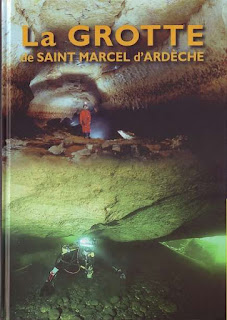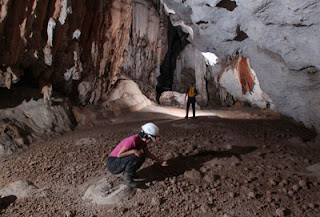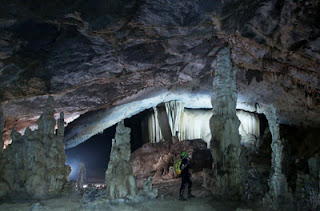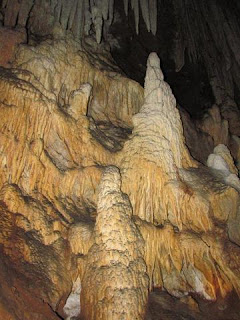To uncover the secrets of what is thought to be the largest cavern ever found in the Mendip Hills in Somerset has taken a group of cavers more than four years of dedicated tunnelling.
And to get to the vast cavern takes half an hour of grovelling on hands and knees, scrambling across massive boulders and squeezing through 700 ft of tiny passages.
So why would a group of retired doctors, teachers and engineers spend their retirement buried underground tunnelling deep into the hills of the Mendips?
Showing posts with label exploration. Show all posts
Showing posts with label exploration. Show all posts
Wednesday, September 12, 2012
Somerset cavers spend their retirement tunnelling into the Mendips
Email ThisBlogThis!Share to TwitterShare to FacebookShare to Pinterest
Sunday, September 9, 2012
Cave divers discover massive grotto hidden in the depths of Cheddar Gorge
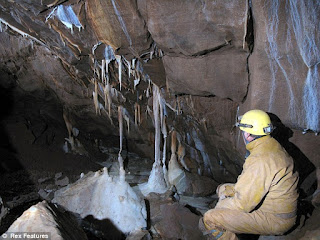 |
| New discovery: The giant underground chamber, named The Frozen Deep, that has recently been found inside Cheddar Gorge in Somerset. |
The huge space, which had been named 'The Frozen Deep' by the team, is a staggering 60 metres in diameter and reaches up to 30 metres high.
It contains stunning calcite formations - including two pure white columns each standing at five-metres tall - surrounded by white flowstone on the walls and floor.
'Tuesday Diggers', a group of local cave divers, discovered the chamber after spending four hours a week for four years digging, breaking rocks and opening 50cm passages.
Hugh Cornwell, director of Cheddar Gorge and Caves, in Somerset, said: 'This is a truly significant discovery by the 'Diggers' which opens up a fascinating new chapter in the history of Mendip cave exploration.
'The question already emerging is whether they can now find a connection from The Frozen Deep to the River Cave.
Email ThisBlogThis!Share to TwitterShare to FacebookShare to Pinterest
Thursday, September 6, 2012
SUI announces “Kozslowski Exploration Fund”
Coinciding with Artur Kozslowski’s first anniversary, SUI are announcing the setting up of a fund to help Irish cavers looking for new caves in Ireland.
In his few years as a caver in Ireland Artur contributed greatly to increasing our knowledge of the Irish underground world both by his own explorations and his enthusiasm and drive.
This fund will offer small contributions to original speleological exploration work for members of SUI in Ireland. Applications can be made to, and will be adjudicated by the expedition sub committee. Further details will be announced at SUICRO 2012
Source: SUI
Source: SUI
Email ThisBlogThis!Share to TwitterShare to FacebookShare to Pinterest
Tuesday, August 28, 2012
Underground passage discovered in Argyll
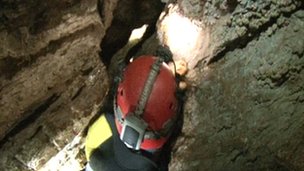 |
| The caving group said it was continuing to map the new discoveries |
About 200m of new passage has been found in a number of caves, with the longest single discovery standing at about 100m in length.
The group said the "rare find" comes only a year after it discovered a major new cave in Applecross.
Exploration and mapping of these caves near Appin is ongoing by the team.
Email ThisBlogThis!Share to TwitterShare to FacebookShare to Pinterest
Radohine Cave Expedition (Albania)
Follow the adventures of the Bulgarian caving team on their 2012 expedition into the Albanian Radohine Mountains on:
http://radohines.bgcaveexplorer.info/
Email ThisBlogThis!Share to TwitterShare to FacebookShare to Pinterest
Wednesday, August 15, 2012
Migovec 2012 Expedition: Longest Cave in Slovenia
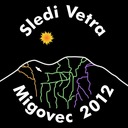
I have the great pleasure of announcing that the JSPDT (Caving Section of the Tolmin Alpine Club) and ICCC (Imperial College Caving Club) have successfully connected System Migovec and System Vrtnarija during the Sledi Vetra 2012 expedition.The combined system is now 24.9 km long and 975 m deep.
This makes it by far the longest known cave in Slovenia, in a system where the majority of passage length is at depths of greater than 500 m.
The connection was made at a depth of ~650 m, during the last pushing trip of the expedition. A climb in the Queens Bed Chamber started last year was completed (named Apollo) and led to 420m of passage (The Milky Way) this was then pushed further to eventually reach a PSS from 1998 in Waterloo, SysMig (see Caves and Caving 84 p18 'The Northern Line', or The Hollow Mountain p100 [1]).
Some of the Slovenes have been working on Migovec every year since the 1970s, ICCC since 1994. There are perhaps more than 50 cavers of Migovec out there who contributed to this enormous project, all of whom share in the enjoyment of this moment.
[1] The Hollow Mountain, the expedition report to 2006 is available free of charge online here:
http://union.ic.ac.uk/rcc/caving/slovenia/intro/slov_intro.php
Interim reports & surveys for the subsequent years may be found on the individual expedition pages linked above.
We gave a recent extended talk on the 2009-2011 at our University, the slides are online & may be a useful introduction / catch up if you caught one of our Hidden Earth lectures:
http://www.scribd.com/doc/86098004/2012-03-Slovenia-Caving-ICCC-Explo-Soc-Talk#
Find out more at http://union.ic.ac.uk/rcc/caving/slovenia/slov2012/
Via Jarvist (Imperial College Caving Club)
Email ThisBlogThis!Share to TwitterShare to FacebookShare to Pinterest
Sunday, August 12, 2012
Krubera - Voronya: The deepest cave in the world became 6 m deeper
The expedition included around 60 representatives of various foreign countries, mainly Ukrainians, as well as 15 Lithuanians.
The news is still sparse, but it seems that the Ukrainian cave diver Gennadiiy Samokhin, was able to find a new lead and push the depth of worlds deepest cave to a new record of 2197 m.
This is six meters deeper than the previous record. A big thanks goes out to the Lithuanian's support team who laid out all the lines.
As for now it remains the only cave with a depth of more than 2000 meters.
The expedition had to deal with high water levels and had some technicial problems (communication was lost for a while) during the beginning of the expedition.
Jurkėnienė said reaching the surface safely was the team's main task now.
"There have been no heavy showers this week but weather conditions remain bad. It is still raining and conditions inside the case are rather bad. They said three siphons they have to dive through to reach the bottom are flooded. It will be a bit harder to come out."
Lithuanian Vytis Vilkas had planned to reach the record depth but he dropped the plan after his health deteriorated.
More news will follow.
The expedition had to deal with high water levels and had some technicial problems (communication was lost for a while) during the beginning of the expedition.
Jurkėnienė said reaching the surface safely was the team's main task now.
"There have been no heavy showers this week but weather conditions remain bad. It is still raining and conditions inside the case are rather bad. They said three siphons they have to dive through to reach the bottom are flooded. It will be a bit harder to come out."
Lithuanian Vytis Vilkas had planned to reach the record depth but he dropped the plan after his health deteriorated.
More news will follow.
Email ThisBlogThis!Share to TwitterShare to FacebookShare to Pinterest
Thursday, August 9, 2012
Video: Pearse Resurgence expedition in New Zealand
A few highlights of this year's Pearse Resurgence expedition in New Zealand, where divers pushed the cave to a new depth of 221m and discovered another 100m of passage.
--
--
--
--
--
--
--
--
--
--
--
--
--
--
--
--
--
--
--
--
--
The Wet Mules have just completed the 2012 expedition to the Pearse River Resurgence near Mt Arthur in the South Island of New Zealand. The six Mules (David Bardi, Craig Challen, John Dalla-Zuanna, Richard “Harry” Harris, Ken Smith and Sandy Varin), were accompanied by diving physician and support Dr Karen Richardson for the 17 day trip.
Both primary objectives of the trip were accomplished. With the assistance of Nelson Speleological Group’s Andrew Smith and Dawn Wood, dye tracing from the Spillway in Nettlebed Cave again confirmed the connection between the two sites. Unfortunately, the dye appeared to be coming from the main passage deeper than 120m, so any hopes of making a shallow connection were lost.
Hence attention shifted back to pushing the deep section of the cave, and once the four habitats were installed at 7, 16, 28 and 38m, and gas was staged in the cave, build-up dives commenced.
On Thursday 12th January Dave and Sandy dived to 180m and completed an extraordinary 7 hour all in-water decompression.
The following day Richard Harris pushed past the end of Craig’s 2011 line at 194m, and laid 70m of line in large passage to a maximum depth of 207m. A total run time of 10½ hours was spent in comfort thanks to the habitats and the surface supplied suit-heating systems.
After two days of rain the resurgence flooded, delaying diving for a day. The final push dive by Craig Challen began on Sunday 15th January as the water levels subsided. Tying off to the end of Harry’s line, he scootered on a short distance only to meet another steep descent. Craig made a final tie off at 221m and returned to the surface after a total dive time of 17 hours. The passage continues beyond, heading deeper.
Ken, JDZ and Craig made tape measure surveys of several areas including the Nightmare Crescent and Big Room area at 120m.
The Wet Mules have just completed the 2012 expedition to the Pearse River Resurgence near Mt Arthur in the South Island of New Zealand. The six Mules (David Bardi, Craig Challen, John Dalla-Zuanna, Richard “Harry” Harris, Ken Smith and Sandy Varin), were accompanied by diving physician and support Dr Karen Richardson for the 17 day trip.
Both primary objectives of the trip were accomplished. With the assistance of Nelson Speleological Group’s Andrew Smith and Dawn Wood, dye tracing from the Spillway in Nettlebed Cave again confirmed the connection between the two sites. Unfortunately, the dye appeared to be coming from the main passage deeper than 120m, so any hopes of making a shallow connection were lost.
Hence attention shifted back to pushing the deep section of the cave, and once the four habitats were installed at 7, 16, 28 and 38m, and gas was staged in the cave, build-up dives commenced.
On Thursday 12th January Dave and Sandy dived to 180m and completed an extraordinary 7 hour all in-water decompression.
The following day Richard Harris pushed past the end of Craig’s 2011 line at 194m, and laid 70m of line in large passage to a maximum depth of 207m. A total run time of 10½ hours was spent in comfort thanks to the habitats and the surface supplied suit-heating systems.
After two days of rain the resurgence flooded, delaying diving for a day. The final push dive by Craig Challen began on Sunday 15th January as the water levels subsided. Tying off to the end of Harry’s line, he scootered on a short distance only to meet another steep descent. Craig made a final tie off at 221m and returned to the surface after a total dive time of 17 hours. The passage continues beyond, heading deeper.
Ken, JDZ and Craig made tape measure surveys of several areas including the Nightmare Crescent and Big Room area at 120m.
Extra resources:
http://www.wetmules.com/home/mules-in-action/pearseexpedition2012news
http://www.stuff.co.nz/nelson-mail/news/6289155/Australian-divers-reach-record-depths-in-caves
http://www.advanceddivermagazine.com/articles/pearse/pearse.html
http://www.deepdiving.net/pearse/
Email ThisBlogThis!Share to TwitterShare to FacebookShare to Pinterest
Wednesday, August 8, 2012
Natural cave unearthed
The forest officials have recently unearthed a natural cave inisde the thick forest, in Kodagu district.
The cave is situated near Anderson stream inside thick forest at Vatekoli, which is 15 kms from Virajpet- Makutta road. The cave is 60 metre long and two metres in height. According to forest department officials, they have heard the sound of water inside the cave. “If there is water inside the cave, then it would be giving shelter to water creatures like fish, crab and so on. Realising the decrease in oxygen inside the cave, the officials did not make an attempt to move further inside the cave.”
The bats will welcome anyone who enters the cave. Normally, snakes live in and around those areas where bats live, say officials. Kodagu Circle Chief Conservator of Forest Deekshith said that the cave must have been formed by the flow of water through limestone and similar rocks. Water seeps into the pores and cracks of rocks and soil and bubbles beneath the earth above. Such caves are called as Solution caves.
The cave is situated near Anderson stream inside thick forest at Vatekoli, which is 15 kms from Virajpet- Makutta road. The cave is 60 metre long and two metres in height. According to forest department officials, they have heard the sound of water inside the cave. “If there is water inside the cave, then it would be giving shelter to water creatures like fish, crab and so on. Realising the decrease in oxygen inside the cave, the officials did not make an attempt to move further inside the cave.”
The bats will welcome anyone who enters the cave. Normally, snakes live in and around those areas where bats live, say officials. Kodagu Circle Chief Conservator of Forest Deekshith said that the cave must have been formed by the flow of water through limestone and similar rocks. Water seeps into the pores and cracks of rocks and soil and bubbles beneath the earth above. Such caves are called as Solution caves.
The soil in the cave is a mixture of white and grey colour and is soft. The roof of the cave is strong. “We could not see the cave fully. The cave will provide an opportunity for the geologists to make a study. I will inform the State government on the discovery of a cave. If the government sends an expert, we will get more details on the cave,” said an official. It is said that the forest guards had discovered it a year ago. However, they had not informed it to the higher authorities. After taking charge, Deekshith visited the spot. In fact, he has marked the route to the cave through GPS.
Source: Deccan Herald
Source: Deccan Herald
Email ThisBlogThis!Share to TwitterShare to FacebookShare to Pinterest
Tuesday, August 7, 2012
Volunteers descend on history of Gibraltar's 200 caves!
One of the aims of the Gibraltar Museum is to encourage volunteer participation in the study of our history and the care of our heritage. With the start of the Gorham’s Cave excavations, help with processing finds will be among the tasks suitable for volunteer effort under supervision. But the involvement of volunteers goes further.
Recently, as part of the wider Gibraltar Caves Project, which was started in 1991,the Cave Unit of the Gibraltar Museum has been working with volunteers in the surveying of Gibraltar’s caves. This is specialised work which is carried out under supervision and is already producing excellent results. The unit is preparing an inventory of Gibraltar’s caves, checking previous work done and looking at each site today. The number of caves now exceeds 200!
Part of the work involves assessing the archaeological and palaeontological potential of each site. Some of these caves were last excavated in the 19th Century, so determining how much archaeology is left is a major challenge.
Others were excavated in the 1960s by the late Mr George Palao, and the unit has not only used Mr Palao’s reports which are in the archives of museum, but has also met with some of his collaborators in order to obtain as much information as possible. The unit is also in contact with - and collaborating with - the GONHS Cliffs and Caves Section who have also worked a number of Gibraltar’s caves.
Recently, as part of the wider Gibraltar Caves Project, which was started in 1991,the Cave Unit of the Gibraltar Museum has been working with volunteers in the surveying of Gibraltar’s caves. This is specialised work which is carried out under supervision and is already producing excellent results. The unit is preparing an inventory of Gibraltar’s caves, checking previous work done and looking at each site today. The number of caves now exceeds 200!
Part of the work involves assessing the archaeological and palaeontological potential of each site. Some of these caves were last excavated in the 19th Century, so determining how much archaeology is left is a major challenge.
Others were excavated in the 1960s by the late Mr George Palao, and the unit has not only used Mr Palao’s reports which are in the archives of museum, but has also met with some of his collaborators in order to obtain as much information as possible. The unit is also in contact with - and collaborating with - the GONHS Cliffs and Caves Section who have also worked a number of Gibraltar’s caves.
Email ThisBlogThis!Share to TwitterShare to FacebookShare to Pinterest
Monday, July 9, 2012
Expedition Documentary: Sima GESM (-1101 m)
| Sima GESM |
The documentary was mainly shot during the 2006 expedition and gives the live report of the discoveries from -950 m and on.
More information on this cave can be found at the dedicated page of the Spanish federation or on the website of the explorers: http://www.espeleoclubpasoslargos.com/
The documentary is split into three parts of about 12 miutes each. Click read more for the other video's.
Email ThisBlogThis!Share to TwitterShare to FacebookShare to Pinterest
Monday, July 2, 2012
Pictures and updated map of Hranická Propast
.jpg) | A few days ago we already reported about this expedition. See this blog post for the video of the dive. Now Krzysztof Starnawski sent an update with a new map of the cave and some extra pictures and tells us firsthand how the expedition went: |
"We just concluded another two day exploration of Hranicka Propast cave. This time i laid guide line from 196 m. to 217 m., passing on 200 meters restriction discovered during our January 2012 expedition.
This restriction is created by fallen rocks and waterlogged tree trunks. Newly discovered passage is huge and has potential to reach 400 meters. Cave is situated in calcium sediment rock which is 600 meters thick, water is warm with heavy mineral content which tells us that is coming from below limestone.
Outcome of our last expedition with terrain geology knowledge allows us to hope that Hranicka Propast can become the deepest submerged cave in the world and her depth can be over 400 meters. Reach to this type of depth is just a question of time since passage is already mapped and guide line is secured.
Restriction discovered in January ended up being way easier than I expected, not that narrow and as I was hoping leads to deeper parts of the cave. Only problem is large amount of waterlogged tree trunks and huge boulders. Thankfully, diver using CCR is not generating large amounts of gas bubbles which could destabilize this tight spot.
Email ThisBlogThis!Share to TwitterShare to FacebookShare to Pinterest
Thursday, June 28, 2012
Czech Cave Diving Expedition into Hranická Propast reaches depth of 217 m
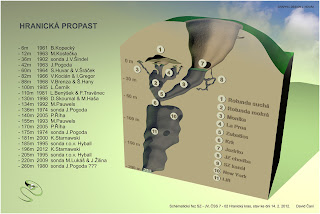 The Hranická Propast cave is located in the east of the Czech Republic, near the town of Moravě.
The Hranická Propast cave is located in the east of the Czech Republic, near the town of Moravě.To enter the cave you have to climb the 315 m high Hůrka hill. Previously divers have installed a cable guidance system to lower their gear easily.
Diving in the cave is pleasant as the water temperatue is about 15-16°C all year round.
The first dives in the cave were done in the sixties. As the system got deeper and deeper people started wondering how far it would go and send in remotely operated vehicles (ROV) in search for the bottom of the well.
Krzysztof Starnawski is now pushing the limits even further.
During a 7.5 h dive, he reached an incredible depth of 217 m. The previous record was -200 m which he accomplished earlier this year. See the bottom of this post for the previous video report.
Below you can see a video report of a the Czech Cave Diving Expedition in the Hranická Propast system, where diver Starnawski went to a depth of 217 m. The film was shot with a GoPro camera, and GRALmarine light.
More info on the cave can be found at his webpage http://www.dualrebreather.com or at http://www.hranickapropast.cz
Email ThisBlogThis!Share to TwitterShare to FacebookShare to Pinterest
Wednesday, June 27, 2012
Advanced Diver Magazine: Issue 7
|
| Content:
|
Email ThisBlogThis!Share to TwitterShare to FacebookShare to Pinterest
Tuesday, June 19, 2012
Cave Diving Expedition connects two caves to St-Marcel d'Ardèche cave system
During several dives in May and June in the "Résurgence du Bateau", in the Ardèche region in central France, JP Baudu succeeded to push the known section of the resurgence from 800 m to 1330 m and succesfully connect it to the St-Marcel d'Ardèche cave system, adding two more entrances to the system (Bateau & Ecluse).
The sump is currently the longest one known in the Ardèche region.
Expedition details:
* First weekend in May: JP & Catherine Baudu put a new line up to 700 m. Visibility: 3 m
* June 9th: JP Baudu continued to put a new line up to 998 m, surpassing the old terminus (800 m) and surveyed at the same time. There seems to be a tunnel on the right side. Visibility: 2 m, dive time: 4 h. Participants: Seb Rocheil, Philippe Imbert, Calos Placido, Catherine Baudu
* June 16th: JP Baudu continues to explore the newly discovered section up to 1330 m ending on a pit at -65 m, where the connection with the St-Marcel d'Ardèche cave system was made. Visibility: 3 m at the start, 1.5 m at the pit. Dive time: 5 h.
Participants: Catherine Baudu, Carlos Placido (Mowgli), Frank Vasseur, Frédéric Bonacossa, Olivier Dufourneaud, Yannick Bohbot
The team wishes to thank Philippe Brunet for all the info on the cave system as well as topo points.
Additional data:
More information on the Bateau-Ecluse system can be found at 1001Siphons.
Click here for a hydrogeological study of the system by Philippe Brunet.
A nice book about the cave has been published in 2008 and is available from Spelunca Library for € 29.
Source: Plongeesout
The sump is currently the longest one known in the Ardèche region.
Expedition details:
* First weekend in May: JP & Catherine Baudu put a new line up to 700 m. Visibility: 3 m
* June 9th: JP Baudu continued to put a new line up to 998 m, surpassing the old terminus (800 m) and surveyed at the same time. There seems to be a tunnel on the right side. Visibility: 2 m, dive time: 4 h. Participants: Seb Rocheil, Philippe Imbert, Calos Placido, Catherine Baudu
* June 16th: JP Baudu continues to explore the newly discovered section up to 1330 m ending on a pit at -65 m, where the connection with the St-Marcel d'Ardèche cave system was made. Visibility: 3 m at the start, 1.5 m at the pit. Dive time: 5 h.
Participants: Catherine Baudu, Carlos Placido (Mowgli), Frank Vasseur, Frédéric Bonacossa, Olivier Dufourneaud, Yannick Bohbot
The team wishes to thank Philippe Brunet for all the info on the cave system as well as topo points.
Additional data:
More information on the Bateau-Ecluse system can be found at 1001Siphons.
Click here for a hydrogeological study of the system by Philippe Brunet.
A nice book about the cave has been published in 2008 and is available from Spelunca Library for € 29.
Source: Plongeesout
Email ThisBlogThis!Share to TwitterShare to FacebookShare to Pinterest
Wednesday, June 6, 2012
Deepest pit found in Lechuguilla Cave
In early May, a team of experienced cave explorers climbed more than 410 feet into a high dome in Lechuguilla Cave, led by Derek Bristol of Colorado.
Upon reaching the top, lead climber James Hunter discovered a maze of previously unknown passages, pits and large rooms, which they called collectively, Oz. One large room measured 600 feet long, 100 to 150 feet wide, and 75 to 150 feet high. It was dubbed Munchkin Land.
Lechuguilla Cave is an extensive cave system in Carlsbad Caverns National Park, known worldwide for its large rooms, unusual minerals, massive and fragile cave formations, and importance in scientific study. This discovery heralds new areas for physical and scientific exploration.
Since mapping began in 1986, explorers have surveyed more than 134.6 miles of cave passages in Lechuguilla Cave. Because of its delicate environment and scientific importance, only about 100 people, usually vetted explorers and scientists, are permitted to enter the cave every year.
Ten cavers from Colorado, South Dakota, New Mexico, California and Arizona participated in the eight-day underground expedition that made the latest discoveries, the greatest amount of distance added to the survey in one day since 1989.
Using laser distance meters, Bristol's team measured the distance from the floor to the final rope anchor of the dome, finding they had climbed 510 feet, making it the deepest pit (natural, direct, vertical expanse) known in the park.
"To understand the sheer size of this space, imagine that a 51-story tower could fit inside," explained Stan Allison, Carlsbad Caverns National Park cave technician.
Upon reaching the top, lead climber James Hunter discovered a maze of previously unknown passages, pits and large rooms, which they called collectively, Oz. One large room measured 600 feet long, 100 to 150 feet wide, and 75 to 150 feet high. It was dubbed Munchkin Land.
Lechuguilla Cave is an extensive cave system in Carlsbad Caverns National Park, known worldwide for its large rooms, unusual minerals, massive and fragile cave formations, and importance in scientific study. This discovery heralds new areas for physical and scientific exploration.
Since mapping began in 1986, explorers have surveyed more than 134.6 miles of cave passages in Lechuguilla Cave. Because of its delicate environment and scientific importance, only about 100 people, usually vetted explorers and scientists, are permitted to enter the cave every year.
Ten cavers from Colorado, South Dakota, New Mexico, California and Arizona participated in the eight-day underground expedition that made the latest discoveries, the greatest amount of distance added to the survey in one day since 1989.
Using laser distance meters, Bristol's team measured the distance from the floor to the final rope anchor of the dome, finding they had climbed 510 feet, making it the deepest pit (natural, direct, vertical expanse) known in the park.
"To understand the sheer size of this space, imagine that a 51-story tower could fit inside," explained Stan Allison, Carlsbad Caverns National Park cave technician.
Email ThisBlogThis!Share to TwitterShare to FacebookShare to Pinterest
Monday, April 30, 2012
Explorers find 41 new caves in Quang Binh Province
Forty-one caves have been discovered at the Phong Nha-Ke Bang National Park-World Heritage Site since March, said the park management board in the central province of Quang Binh on Tuesday.
The caves were discovered by explorers of the British Royal Cave Research Association, along a 20 kilometre stretch.
Of the 41 new caves, the Ky cave is the deepest one found in Vietnam. The widest is Cua Nho, though its entrance is so narrow that only one person can pass through. However, in its inside it widens to give a huge feeling of spaciousness.
Luu Minh Thanh, director of the Phong Nha-Ke Bang National Park, said that Japan’s National Television Station (NHK) will arrive by April 26 to make a film on Son Doong Cave, which will be widely broadcast in 200 nations and territories across the globe.
The caves were discovered by explorers of the British Royal Cave Research Association, along a 20 kilometre stretch.
Of the 41 new caves, the Ky cave is the deepest one found in Vietnam. The widest is Cua Nho, though its entrance is so narrow that only one person can pass through. However, in its inside it widens to give a huge feeling of spaciousness.
Luu Minh Thanh, director of the Phong Nha-Ke Bang National Park, said that Japan’s National Television Station (NHK) will arrive by April 26 to make a film on Son Doong Cave, which will be widely broadcast in 200 nations and territories across the globe.
Email ThisBlogThis!Share to TwitterShare to FacebookShare to Pinterest
Wednesday, April 4, 2012
The journey of a caving addict: Howard Limbert
 |
| Howard Limbert (L) and his wife at Tra Ang Cav |
22 years ago Howard Limbert, the most recent leader of the British Cave Research Association, made his first expedition to the Phong Nha cave of the cave systems of Phong Nha - Ke Bang National Park in the central province of Quang Binh.
After the visit, Howard and his team explored many of the cave’s wonderful features and values that were later featured in the world famous Lonely Planet guidebook. Since then, more tourists have come to the site.
The park has so far attracted around 3 million tourists and improved the lives of people living in the area by creating jobs for 2,600 residents.
From a 15-year-old boy’s caving passion to the world’s largest cave
Email ThisBlogThis!Share to TwitterShare to FacebookShare to Pinterest
Tuesday, April 3, 2012
Experts will lecture on caves in Botswana
Two large-scale surveys for buried caverns in the remote north-west of Botswana will be the subject of a public lecture at Origins Centre this month.
Speakers Gavin Selfe and Roger Ellis will discuss the exploration, which involves the Drotsky’s (Gcwihaba) and Koanaka cave areas. The talk is co-hosted by the Geological Society of South Africa (GSSA).
The cave project, at the behest of the Botswana government, aims to develop a new national park in the remote north of the country in which the caves will play a major role. Currently known as the Gcwihaba Caves Project, the park has been cited for World Heritage status and is intended to add to Botswana’s diverse list of tourist attractions.
The method by which the new caves have been located, accessed and explored is what makes the project so unique. By applying scientific, engineering and caving skills, the mystery of Botswana’s underground heritage is now being revealed, and the presenters will take audience members on a journey of adventure and discovery deep within the Kalahari.
Gavin Selfe is a consulting geophysicist for various mineral exploration companies.
Roger Ellis, a retired engineer, has been involved in the discovery and exploration of many of Southern Africa’s premier wild caves.
Date: Tuesday 17 April 2012
Venue: Origins Centre
Time: 18h00 for 18h30
Cost: R45/R35 Wits students and staff and GSSA members
Bookings essential: [email protected]
Web site: http://www.origins.org.za
Speakers Gavin Selfe and Roger Ellis will discuss the exploration, which involves the Drotsky’s (Gcwihaba) and Koanaka cave areas. The talk is co-hosted by the Geological Society of South Africa (GSSA).
The cave project, at the behest of the Botswana government, aims to develop a new national park in the remote north of the country in which the caves will play a major role. Currently known as the Gcwihaba Caves Project, the park has been cited for World Heritage status and is intended to add to Botswana’s diverse list of tourist attractions.
The method by which the new caves have been located, accessed and explored is what makes the project so unique. By applying scientific, engineering and caving skills, the mystery of Botswana’s underground heritage is now being revealed, and the presenters will take audience members on a journey of adventure and discovery deep within the Kalahari.
Gavin Selfe is a consulting geophysicist for various mineral exploration companies.
Roger Ellis, a retired engineer, has been involved in the discovery and exploration of many of Southern Africa’s premier wild caves.
Date: Tuesday 17 April 2012
Venue: Origins Centre
Time: 18h00 for 18h30
Cost: R45/R35 Wits students and staff and GSSA members
Bookings essential: [email protected]
Web site: http://www.origins.org.za
Source: Artlink
Email ThisBlogThis!Share to TwitterShare to FacebookShare to Pinterest
Friday, March 23, 2012
Beautiful new cave discovered in Quang Binh Province
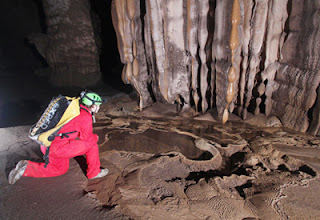 |
| The recently discovered cave in Quang Binh Province by the British Royal Cave Research Association |
The recently discovered cave in Quang Binh Province by the British Royal Cave Research Association
Son Doong Cave has been recognised as the biggest cave in the world by National Geographic.
The new cave is called Va Cave and is located among a group of eight other caves. The team of explorers discovered it after a study and research of the site in the province. The British Royal Cave Research Association has so far discovered 15 new caves.
Among them, Va Cave is said to have stalactites that are even more stunning and spectacular than those in the Son Doong Cave.
The explorers said that they had never seen a cave with such beautiful stalactites, as much as 1.7kilometres in length.
According to initial reports, the Va Cave was found by a local man named Ho Khanh, who took the explorers to the site of the cave, located 400metres from the Son Doong Cave.
Source: Saigon Daily
Email ThisBlogThis!Share to TwitterShare to FacebookShare to Pinterest
Subscribe to:
Posts (Atom)
Showing posts with label exploration. Show all posts
Showing posts with label exploration. Show all posts
Wednesday, September 12, 2012
Somerset cavers spend their retirement tunnelling into the Mendips
To uncover the secrets of what is thought to be the largest cavern ever found in the Mendip Hills in Somerset has taken a group of cavers more than four years of dedicated tunnelling.
And to get to the vast cavern takes half an hour of grovelling on hands and knees, scrambling across massive boulders and squeezing through 700 ft of tiny passages.
So why would a group of retired doctors, teachers and engineers spend their retirement buried underground tunnelling deep into the hills of the Mendips?
And to get to the vast cavern takes half an hour of grovelling on hands and knees, scrambling across massive boulders and squeezing through 700 ft of tiny passages.
So why would a group of retired doctors, teachers and engineers spend their retirement buried underground tunnelling deep into the hills of the Mendips?
Labels:
Cheddar Gorge,
exploration,
UK,
video
Location:
Somerset, Verenigd Koninkrijk
Sunday, September 9, 2012
Cave divers discover massive grotto hidden in the depths of Cheddar Gorge
 |
| New discovery: The giant underground chamber, named The Frozen Deep, that has recently been found inside Cheddar Gorge in Somerset. |
The huge space, which had been named 'The Frozen Deep' by the team, is a staggering 60 metres in diameter and reaches up to 30 metres high.
It contains stunning calcite formations - including two pure white columns each standing at five-metres tall - surrounded by white flowstone on the walls and floor.
'Tuesday Diggers', a group of local cave divers, discovered the chamber after spending four hours a week for four years digging, breaking rocks and opening 50cm passages.
Hugh Cornwell, director of Cheddar Gorge and Caves, in Somerset, said: 'This is a truly significant discovery by the 'Diggers' which opens up a fascinating new chapter in the history of Mendip cave exploration.
'The question already emerging is whether they can now find a connection from The Frozen Deep to the River Cave.
Labels:
cave diving,
expedition,
exploration,
River Cave,
The Frozen Deep,
UK
Location:
Cheddar Gorge, Cheddar, Somerset BS27, Verenigd Koninkrijk
Thursday, September 6, 2012
SUI announces “Kozslowski Exploration Fund”
Coinciding with Artur Kozslowski’s first anniversary, SUI are announcing the setting up of a fund to help Irish cavers looking for new caves in Ireland.
In his few years as a caver in Ireland Artur contributed greatly to increasing our knowledge of the Irish underground world both by his own explorations and his enthusiasm and drive.
This fund will offer small contributions to original speleological exploration work for members of SUI in Ireland. Applications can be made to, and will be adjudicated by the expedition sub committee. Further details will be announced at SUICRO 2012
Source: SUI
Source: SUI
Labels:
Artur Kozlowski,
exploration,
funding,
Ireland,
SUI
Location:
Ierland
Tuesday, August 28, 2012
Underground passage discovered in Argyll
 |
| The caving group said it was continuing to map the new discoveries |
About 200m of new passage has been found in a number of caves, with the longest single discovery standing at about 100m in length.
The group said the "rare find" comes only a year after it discovered a major new cave in Applecross.
Exploration and mapping of these caves near Appin is ongoing by the team.
Labels:
exploration,
Scotland,
UK
Location:
Schotland, Verenigd Koninkrijk
Radohine Cave Expedition (Albania)
Follow the adventures of the Bulgarian caving team on their 2012 expedition into the Albanian Radohine Mountains on:
http://radohines.bgcaveexplorer.info/
Labels:
Albania,
expedition,
exploration,
Radohine Mountains
Location:
Albanië
Wednesday, August 15, 2012
Migovec 2012 Expedition: Longest Cave in Slovenia

I have the great pleasure of announcing that the JSPDT (Caving Section of the Tolmin Alpine Club) and ICCC (Imperial College Caving Club) have successfully connected System Migovec and System Vrtnarija during the Sledi Vetra 2012 expedition.The combined system is now 24.9 km long and 975 m deep.
This makes it by far the longest known cave in Slovenia, in a system where the majority of passage length is at depths of greater than 500 m.
The connection was made at a depth of ~650 m, during the last pushing trip of the expedition. A climb in the Queens Bed Chamber started last year was completed (named Apollo) and led to 420m of passage (The Milky Way) this was then pushed further to eventually reach a PSS from 1998 in Waterloo, SysMig (see Caves and Caving 84 p18 'The Northern Line', or The Hollow Mountain p100 [1]).
Some of the Slovenes have been working on Migovec every year since the 1970s, ICCC since 1994. There are perhaps more than 50 cavers of Migovec out there who contributed to this enormous project, all of whom share in the enjoyment of this moment.
[1] The Hollow Mountain, the expedition report to 2006 is available free of charge online here:
http://union.ic.ac.uk/rcc/caving/slovenia/intro/slov_intro.php
Interim reports & surveys for the subsequent years may be found on the individual expedition pages linked above.
We gave a recent extended talk on the 2009-2011 at our University, the slides are online & may be a useful introduction / catch up if you caught one of our Hidden Earth lectures:
http://www.scribd.com/doc/86098004/2012-03-Slovenia-Caving-ICCC-Explo-Soc-Talk#
Find out more at http://union.ic.ac.uk/rcc/caving/slovenia/slov2012/
Via Jarvist (Imperial College Caving Club)
Labels:
expedition,
exploration,
ICCC,
JSPDT,
Migovec,
record,
Slovenia,
Vrtnarija
Sunday, August 12, 2012
Krubera - Voronya: The deepest cave in the world became 6 m deeper
The expedition included around 60 representatives of various foreign countries, mainly Ukrainians, as well as 15 Lithuanians.
The news is still sparse, but it seems that the Ukrainian cave diver Gennadiiy Samokhin, was able to find a new lead and push the depth of worlds deepest cave to a new record of 2197 m.
This is six meters deeper than the previous record. A big thanks goes out to the Lithuanian's support team who laid out all the lines.
As for now it remains the only cave with a depth of more than 2000 meters.
The expedition had to deal with high water levels and had some technicial problems (communication was lost for a while) during the beginning of the expedition.
Jurkėnienė said reaching the surface safely was the team's main task now.
"There have been no heavy showers this week but weather conditions remain bad. It is still raining and conditions inside the case are rather bad. They said three siphons they have to dive through to reach the bottom are flooded. It will be a bit harder to come out."
Lithuanian Vytis Vilkas had planned to reach the record depth but he dropped the plan after his health deteriorated.
More news will follow.
The expedition had to deal with high water levels and had some technicial problems (communication was lost for a while) during the beginning of the expedition.
Jurkėnienė said reaching the surface safely was the team's main task now.
"There have been no heavy showers this week but weather conditions remain bad. It is still raining and conditions inside the case are rather bad. They said three siphons they have to dive through to reach the bottom are flooded. It will be a bit harder to come out."
Lithuanian Vytis Vilkas had planned to reach the record depth but he dropped the plan after his health deteriorated.
More news will follow.
Labels:
-1000,
Abkhazia,
expedition,
exploration,
Gennadiiy Samokhin,
Krubera,
Voronya,
world record
Location:
Abkhazia, Georgië
Thursday, August 9, 2012
Video: Pearse Resurgence expedition in New Zealand
A few highlights of this year's Pearse Resurgence expedition in New Zealand, where divers pushed the cave to a new depth of 221m and discovered another 100m of passage.
--
--
--
--
--
--
--
--
--
--
--
--
--
--
--
--
--
--
--
--
--
The Wet Mules have just completed the 2012 expedition to the Pearse River Resurgence near Mt Arthur in the South Island of New Zealand. The six Mules (David Bardi, Craig Challen, John Dalla-Zuanna, Richard “Harry” Harris, Ken Smith and Sandy Varin), were accompanied by diving physician and support Dr Karen Richardson for the 17 day trip.
Both primary objectives of the trip were accomplished. With the assistance of Nelson Speleological Group’s Andrew Smith and Dawn Wood, dye tracing from the Spillway in Nettlebed Cave again confirmed the connection between the two sites. Unfortunately, the dye appeared to be coming from the main passage deeper than 120m, so any hopes of making a shallow connection were lost.
Hence attention shifted back to pushing the deep section of the cave, and once the four habitats were installed at 7, 16, 28 and 38m, and gas was staged in the cave, build-up dives commenced.
On Thursday 12th January Dave and Sandy dived to 180m and completed an extraordinary 7 hour all in-water decompression.
The following day Richard Harris pushed past the end of Craig’s 2011 line at 194m, and laid 70m of line in large passage to a maximum depth of 207m. A total run time of 10½ hours was spent in comfort thanks to the habitats and the surface supplied suit-heating systems.
After two days of rain the resurgence flooded, delaying diving for a day. The final push dive by Craig Challen began on Sunday 15th January as the water levels subsided. Tying off to the end of Harry’s line, he scootered on a short distance only to meet another steep descent. Craig made a final tie off at 221m and returned to the surface after a total dive time of 17 hours. The passage continues beyond, heading deeper.
Ken, JDZ and Craig made tape measure surveys of several areas including the Nightmare Crescent and Big Room area at 120m.
The Wet Mules have just completed the 2012 expedition to the Pearse River Resurgence near Mt Arthur in the South Island of New Zealand. The six Mules (David Bardi, Craig Challen, John Dalla-Zuanna, Richard “Harry” Harris, Ken Smith and Sandy Varin), were accompanied by diving physician and support Dr Karen Richardson for the 17 day trip.
Both primary objectives of the trip were accomplished. With the assistance of Nelson Speleological Group’s Andrew Smith and Dawn Wood, dye tracing from the Spillway in Nettlebed Cave again confirmed the connection between the two sites. Unfortunately, the dye appeared to be coming from the main passage deeper than 120m, so any hopes of making a shallow connection were lost.
Hence attention shifted back to pushing the deep section of the cave, and once the four habitats were installed at 7, 16, 28 and 38m, and gas was staged in the cave, build-up dives commenced.
On Thursday 12th January Dave and Sandy dived to 180m and completed an extraordinary 7 hour all in-water decompression.
The following day Richard Harris pushed past the end of Craig’s 2011 line at 194m, and laid 70m of line in large passage to a maximum depth of 207m. A total run time of 10½ hours was spent in comfort thanks to the habitats and the surface supplied suit-heating systems.
After two days of rain the resurgence flooded, delaying diving for a day. The final push dive by Craig Challen began on Sunday 15th January as the water levels subsided. Tying off to the end of Harry’s line, he scootered on a short distance only to meet another steep descent. Craig made a final tie off at 221m and returned to the surface after a total dive time of 17 hours. The passage continues beyond, heading deeper.
Ken, JDZ and Craig made tape measure surveys of several areas including the Nightmare Crescent and Big Room area at 120m.
Extra resources:
http://www.wetmules.com/home/mules-in-action/pearseexpedition2012news
http://www.stuff.co.nz/nelson-mail/news/6289155/Australian-divers-reach-record-depths-in-caves
http://www.advanceddivermagazine.com/articles/pearse/pearse.html
http://www.deepdiving.net/pearse/
Labels:
cave diving,
expedition,
exploration,
Nettlebed Cave,
New Zealand,
Pearse resurgence,
video
Location:
Mount Arthur, Tasman 7073, Nieuw-Zeeland
Wednesday, August 8, 2012
Natural cave unearthed
The forest officials have recently unearthed a natural cave inisde the thick forest, in Kodagu district.
The cave is situated near Anderson stream inside thick forest at Vatekoli, which is 15 kms from Virajpet- Makutta road. The cave is 60 metre long and two metres in height. According to forest department officials, they have heard the sound of water inside the cave. “If there is water inside the cave, then it would be giving shelter to water creatures like fish, crab and so on. Realising the decrease in oxygen inside the cave, the officials did not make an attempt to move further inside the cave.”
The bats will welcome anyone who enters the cave. Normally, snakes live in and around those areas where bats live, say officials. Kodagu Circle Chief Conservator of Forest Deekshith said that the cave must have been formed by the flow of water through limestone and similar rocks. Water seeps into the pores and cracks of rocks and soil and bubbles beneath the earth above. Such caves are called as Solution caves.
The cave is situated near Anderson stream inside thick forest at Vatekoli, which is 15 kms from Virajpet- Makutta road. The cave is 60 metre long and two metres in height. According to forest department officials, they have heard the sound of water inside the cave. “If there is water inside the cave, then it would be giving shelter to water creatures like fish, crab and so on. Realising the decrease in oxygen inside the cave, the officials did not make an attempt to move further inside the cave.”
The bats will welcome anyone who enters the cave. Normally, snakes live in and around those areas where bats live, say officials. Kodagu Circle Chief Conservator of Forest Deekshith said that the cave must have been formed by the flow of water through limestone and similar rocks. Water seeps into the pores and cracks of rocks and soil and bubbles beneath the earth above. Such caves are called as Solution caves.
The soil in the cave is a mixture of white and grey colour and is soft. The roof of the cave is strong. “We could not see the cave fully. The cave will provide an opportunity for the geologists to make a study. I will inform the State government on the discovery of a cave. If the government sends an expert, we will get more details on the cave,” said an official. It is said that the forest guards had discovered it a year ago. However, they had not informed it to the higher authorities. After taking charge, Deekshith visited the spot. In fact, he has marked the route to the cave through GPS.
Source: Deccan Herald
Source: Deccan Herald
Tuesday, August 7, 2012
Volunteers descend on history of Gibraltar's 200 caves!
One of the aims of the Gibraltar Museum is to encourage volunteer participation in the study of our history and the care of our heritage. With the start of the Gorham’s Cave excavations, help with processing finds will be among the tasks suitable for volunteer effort under supervision. But the involvement of volunteers goes further.
Recently, as part of the wider Gibraltar Caves Project, which was started in 1991,the Cave Unit of the Gibraltar Museum has been working with volunteers in the surveying of Gibraltar’s caves. This is specialised work which is carried out under supervision and is already producing excellent results. The unit is preparing an inventory of Gibraltar’s caves, checking previous work done and looking at each site today. The number of caves now exceeds 200!
Part of the work involves assessing the archaeological and palaeontological potential of each site. Some of these caves were last excavated in the 19th Century, so determining how much archaeology is left is a major challenge.
Others were excavated in the 1960s by the late Mr George Palao, and the unit has not only used Mr Palao’s reports which are in the archives of museum, but has also met with some of his collaborators in order to obtain as much information as possible. The unit is also in contact with - and collaborating with - the GONHS Cliffs and Caves Section who have also worked a number of Gibraltar’s caves.
Recently, as part of the wider Gibraltar Caves Project, which was started in 1991,the Cave Unit of the Gibraltar Museum has been working with volunteers in the surveying of Gibraltar’s caves. This is specialised work which is carried out under supervision and is already producing excellent results. The unit is preparing an inventory of Gibraltar’s caves, checking previous work done and looking at each site today. The number of caves now exceeds 200!
Part of the work involves assessing the archaeological and palaeontological potential of each site. Some of these caves were last excavated in the 19th Century, so determining how much archaeology is left is a major challenge.
Others were excavated in the 1960s by the late Mr George Palao, and the unit has not only used Mr Palao’s reports which are in the archives of museum, but has also met with some of his collaborators in order to obtain as much information as possible. The unit is also in contact with - and collaborating with - the GONHS Cliffs and Caves Section who have also worked a number of Gibraltar’s caves.
Labels:
expedition,
exploration,
Gibraltar,
Gorhams Cave
Location:
Gibraltar
Monday, July 9, 2012
Expedition Documentary: Sima GESM (-1101 m)
| Sima GESM |
The documentary was mainly shot during the 2006 expedition and gives the live report of the discoveries from -950 m and on.
More information on this cave can be found at the dedicated page of the Spanish federation or on the website of the explorers: http://www.espeleoclubpasoslargos.com/
The documentary is split into three parts of about 12 miutes each. Click read more for the other video's.
Labels:
-1000,
expedition,
exploration,
Sima de la Luz,
Sima GESM,
Sistema de las Nieves,
Spain,
video
Location:
Tolox, 29109 Tolox, Spanje
Monday, July 2, 2012
Pictures and updated map of Hranická Propast
.jpg) | A few days ago we already reported about this expedition. See this blog post for the video of the dive. Now Krzysztof Starnawski sent an update with a new map of the cave and some extra pictures and tells us firsthand how the expedition went: |
"We just concluded another two day exploration of Hranicka Propast cave. This time i laid guide line from 196 m. to 217 m., passing on 200 meters restriction discovered during our January 2012 expedition.
This restriction is created by fallen rocks and waterlogged tree trunks. Newly discovered passage is huge and has potential to reach 400 meters. Cave is situated in calcium sediment rock which is 600 meters thick, water is warm with heavy mineral content which tells us that is coming from below limestone.
Outcome of our last expedition with terrain geology knowledge allows us to hope that Hranicka Propast can become the deepest submerged cave in the world and her depth can be over 400 meters. Reach to this type of depth is just a question of time since passage is already mapped and guide line is secured.
Restriction discovered in January ended up being way easier than I expected, not that narrow and as I was hoping leads to deeper parts of the cave. Only problem is large amount of waterlogged tree trunks and huge boulders. Thankfully, diver using CCR is not generating large amounts of gas bubbles which could destabilize this tight spot.
Labels:
cave diving,
Czech Republic,
expedition,
exploration,
Hranicka Propast,
survey
Location:
Hranická, 751 31 Lipník nad Be�?vou, Tsjechië
Thursday, June 28, 2012
Czech Cave Diving Expedition into Hranická Propast reaches depth of 217 m
 The Hranická Propast cave is located in the east of the Czech Republic, near the town of Moravě.
The Hranická Propast cave is located in the east of the Czech Republic, near the town of Moravě.To enter the cave you have to climb the 315 m high Hůrka hill. Previously divers have installed a cable guidance system to lower their gear easily.
Diving in the cave is pleasant as the water temperatue is about 15-16°C all year round.
The first dives in the cave were done in the sixties. As the system got deeper and deeper people started wondering how far it would go and send in remotely operated vehicles (ROV) in search for the bottom of the well.
Krzysztof Starnawski is now pushing the limits even further.
During a 7.5 h dive, he reached an incredible depth of 217 m. The previous record was -200 m which he accomplished earlier this year. See the bottom of this post for the previous video report.
Below you can see a video report of a the Czech Cave Diving Expedition in the Hranická Propast system, where diver Starnawski went to a depth of 217 m. The film was shot with a GoPro camera, and GRALmarine light.
More info on the cave can be found at his webpage http://www.dualrebreather.com or at http://www.hranickapropast.cz
Labels:
cave diving,
Czech Republic,
expedition,
exploration,
Hranicka Propast,
survey,
video
Location:
Morava Tsjechië
Wednesday, June 27, 2012
Advanced Diver Magazine: Issue 7
|
| Content:
|
Tuesday, June 19, 2012
Cave Diving Expedition connects two caves to St-Marcel d'Ardèche cave system
During several dives in May and June in the "Résurgence du Bateau", in the Ardèche region in central France, JP Baudu succeeded to push the known section of the resurgence from 800 m to 1330 m and succesfully connect it to the St-Marcel d'Ardèche cave system, adding two more entrances to the system (Bateau & Ecluse).
The sump is currently the longest one known in the Ardèche region.
Expedition details:
* First weekend in May: JP & Catherine Baudu put a new line up to 700 m. Visibility: 3 m
* June 9th: JP Baudu continued to put a new line up to 998 m, surpassing the old terminus (800 m) and surveyed at the same time. There seems to be a tunnel on the right side. Visibility: 2 m, dive time: 4 h. Participants: Seb Rocheil, Philippe Imbert, Calos Placido, Catherine Baudu
* June 16th: JP Baudu continues to explore the newly discovered section up to 1330 m ending on a pit at -65 m, where the connection with the St-Marcel d'Ardèche cave system was made. Visibility: 3 m at the start, 1.5 m at the pit. Dive time: 5 h.
Participants: Catherine Baudu, Carlos Placido (Mowgli), Frank Vasseur, Frédéric Bonacossa, Olivier Dufourneaud, Yannick Bohbot
The team wishes to thank Philippe Brunet for all the info on the cave system as well as topo points.
Additional data:
More information on the Bateau-Ecluse system can be found at 1001Siphons.
Click here for a hydrogeological study of the system by Philippe Brunet.
A nice book about the cave has been published in 2008 and is available from Spelunca Library for € 29.
Source: Plongeesout
The sump is currently the longest one known in the Ardèche region.
Expedition details:
* First weekend in May: JP & Catherine Baudu put a new line up to 700 m. Visibility: 3 m
* June 9th: JP Baudu continued to put a new line up to 998 m, surpassing the old terminus (800 m) and surveyed at the same time. There seems to be a tunnel on the right side. Visibility: 2 m, dive time: 4 h. Participants: Seb Rocheil, Philippe Imbert, Calos Placido, Catherine Baudu
* June 16th: JP Baudu continues to explore the newly discovered section up to 1330 m ending on a pit at -65 m, where the connection with the St-Marcel d'Ardèche cave system was made. Visibility: 3 m at the start, 1.5 m at the pit. Dive time: 5 h.
Participants: Catherine Baudu, Carlos Placido (Mowgli), Frank Vasseur, Frédéric Bonacossa, Olivier Dufourneaud, Yannick Bohbot
The team wishes to thank Philippe Brunet for all the info on the cave system as well as topo points.
Additional data:
More information on the Bateau-Ecluse system can be found at 1001Siphons.
Click here for a hydrogeological study of the system by Philippe Brunet.
A nice book about the cave has been published in 2008 and is available from Spelunca Library for € 29.
Source: Plongeesout
Labels:
cave diving,
expedition,
exploration,
France,
JP Baudu,
Résurgence du Bateau,
Source de l'Ecluse,
St-Marcel d'Ardèche
Location:
Saint-Marcel-d'Ardèche, Frankrijk
Wednesday, June 6, 2012
Deepest pit found in Lechuguilla Cave
In early May, a team of experienced cave explorers climbed more than 410 feet into a high dome in Lechuguilla Cave, led by Derek Bristol of Colorado.
Upon reaching the top, lead climber James Hunter discovered a maze of previously unknown passages, pits and large rooms, which they called collectively, Oz. One large room measured 600 feet long, 100 to 150 feet wide, and 75 to 150 feet high. It was dubbed Munchkin Land.
Lechuguilla Cave is an extensive cave system in Carlsbad Caverns National Park, known worldwide for its large rooms, unusual minerals, massive and fragile cave formations, and importance in scientific study. This discovery heralds new areas for physical and scientific exploration.
Since mapping began in 1986, explorers have surveyed more than 134.6 miles of cave passages in Lechuguilla Cave. Because of its delicate environment and scientific importance, only about 100 people, usually vetted explorers and scientists, are permitted to enter the cave every year.
Ten cavers from Colorado, South Dakota, New Mexico, California and Arizona participated in the eight-day underground expedition that made the latest discoveries, the greatest amount of distance added to the survey in one day since 1989.
Using laser distance meters, Bristol's team measured the distance from the floor to the final rope anchor of the dome, finding they had climbed 510 feet, making it the deepest pit (natural, direct, vertical expanse) known in the park.
"To understand the sheer size of this space, imagine that a 51-story tower could fit inside," explained Stan Allison, Carlsbad Caverns National Park cave technician.
Upon reaching the top, lead climber James Hunter discovered a maze of previously unknown passages, pits and large rooms, which they called collectively, Oz. One large room measured 600 feet long, 100 to 150 feet wide, and 75 to 150 feet high. It was dubbed Munchkin Land.
Lechuguilla Cave is an extensive cave system in Carlsbad Caverns National Park, known worldwide for its large rooms, unusual minerals, massive and fragile cave formations, and importance in scientific study. This discovery heralds new areas for physical and scientific exploration.
Since mapping began in 1986, explorers have surveyed more than 134.6 miles of cave passages in Lechuguilla Cave. Because of its delicate environment and scientific importance, only about 100 people, usually vetted explorers and scientists, are permitted to enter the cave every year.
Ten cavers from Colorado, South Dakota, New Mexico, California and Arizona participated in the eight-day underground expedition that made the latest discoveries, the greatest amount of distance added to the survey in one day since 1989.
Using laser distance meters, Bristol's team measured the distance from the floor to the final rope anchor of the dome, finding they had climbed 510 feet, making it the deepest pit (natural, direct, vertical expanse) known in the park.
"To understand the sheer size of this space, imagine that a 51-story tower could fit inside," explained Stan Allison, Carlsbad Caverns National Park cave technician.
Labels:
expedition,
exploration,
Lechuguilla,
USA
Location:
Carlsbad Caverns, 727 Carlsbad Cavern Hwy, Carlsbad, New Mexico 88220, Verenigde Staten
Monday, April 30, 2012
Explorers find 41 new caves in Quang Binh Province
Forty-one caves have been discovered at the Phong Nha-Ke Bang National Park-World Heritage Site since March, said the park management board in the central province of Quang Binh on Tuesday.
The caves were discovered by explorers of the British Royal Cave Research Association, along a 20 kilometre stretch.
Of the 41 new caves, the Ky cave is the deepest one found in Vietnam. The widest is Cua Nho, though its entrance is so narrow that only one person can pass through. However, in its inside it widens to give a huge feeling of spaciousness.
Luu Minh Thanh, director of the Phong Nha-Ke Bang National Park, said that Japan’s National Television Station (NHK) will arrive by April 26 to make a film on Son Doong Cave, which will be widely broadcast in 200 nations and territories across the globe.
The caves were discovered by explorers of the British Royal Cave Research Association, along a 20 kilometre stretch.
Of the 41 new caves, the Ky cave is the deepest one found in Vietnam. The widest is Cua Nho, though its entrance is so narrow that only one person can pass through. However, in its inside it widens to give a huge feeling of spaciousness.
Luu Minh Thanh, director of the Phong Nha-Ke Bang National Park, said that Japan’s National Television Station (NHK) will arrive by April 26 to make a film on Son Doong Cave, which will be widely broadcast in 200 nations and territories across the globe.
Labels:
cave,
expedition,
exploration,
Vietnam
Location:
Nationaal park Phong Nha-Kẻ Bàng, Vietnam
Wednesday, April 4, 2012
The journey of a caving addict: Howard Limbert
 |
| Howard Limbert (L) and his wife at Tra Ang Cav |
22 years ago Howard Limbert, the most recent leader of the British Cave Research Association, made his first expedition to the Phong Nha cave of the cave systems of Phong Nha - Ke Bang National Park in the central province of Quang Binh.
After the visit, Howard and his team explored many of the cave’s wonderful features and values that were later featured in the world famous Lonely Planet guidebook. Since then, more tourists have come to the site.
The park has so far attracted around 3 million tourists and improved the lives of people living in the area by creating jobs for 2,600 residents.
From a 15-year-old boy’s caving passion to the world’s largest cave
Labels:
expedition,
exploration,
Howard Limbert,
Vietnam
Location:
Verenigd Koninkrijk
Tuesday, April 3, 2012
Experts will lecture on caves in Botswana
Two large-scale surveys for buried caverns in the remote north-west of Botswana will be the subject of a public lecture at Origins Centre this month.
Speakers Gavin Selfe and Roger Ellis will discuss the exploration, which involves the Drotsky’s (Gcwihaba) and Koanaka cave areas. The talk is co-hosted by the Geological Society of South Africa (GSSA).
The cave project, at the behest of the Botswana government, aims to develop a new national park in the remote north of the country in which the caves will play a major role. Currently known as the Gcwihaba Caves Project, the park has been cited for World Heritage status and is intended to add to Botswana’s diverse list of tourist attractions.
The method by which the new caves have been located, accessed and explored is what makes the project so unique. By applying scientific, engineering and caving skills, the mystery of Botswana’s underground heritage is now being revealed, and the presenters will take audience members on a journey of adventure and discovery deep within the Kalahari.
Gavin Selfe is a consulting geophysicist for various mineral exploration companies.
Roger Ellis, a retired engineer, has been involved in the discovery and exploration of many of Southern Africa’s premier wild caves.
Date: Tuesday 17 April 2012
Venue: Origins Centre
Time: 18h00 for 18h30
Cost: R45/R35 Wits students and staff and GSSA members
Bookings essential: [email protected]
Web site: http://www.origins.org.za
Speakers Gavin Selfe and Roger Ellis will discuss the exploration, which involves the Drotsky’s (Gcwihaba) and Koanaka cave areas. The talk is co-hosted by the Geological Society of South Africa (GSSA).
The cave project, at the behest of the Botswana government, aims to develop a new national park in the remote north of the country in which the caves will play a major role. Currently known as the Gcwihaba Caves Project, the park has been cited for World Heritage status and is intended to add to Botswana’s diverse list of tourist attractions.
The method by which the new caves have been located, accessed and explored is what makes the project so unique. By applying scientific, engineering and caving skills, the mystery of Botswana’s underground heritage is now being revealed, and the presenters will take audience members on a journey of adventure and discovery deep within the Kalahari.
Gavin Selfe is a consulting geophysicist for various mineral exploration companies.
Roger Ellis, a retired engineer, has been involved in the discovery and exploration of many of Southern Africa’s premier wild caves.
Date: Tuesday 17 April 2012
Venue: Origins Centre
Time: 18h00 for 18h30
Cost: R45/R35 Wits students and staff and GSSA members
Bookings essential: [email protected]
Web site: http://www.origins.org.za
Source: Artlink
Labels:
Botswana,
event,
exploration
Location:
Gcwihaba, Gaborone, Botswana
Friday, March 23, 2012
Beautiful new cave discovered in Quang Binh Province
 |
| The recently discovered cave in Quang Binh Province by the British Royal Cave Research Association |
The recently discovered cave in Quang Binh Province by the British Royal Cave Research Association
Son Doong Cave has been recognised as the biggest cave in the world by National Geographic.
The new cave is called Va Cave and is located among a group of eight other caves. The team of explorers discovered it after a study and research of the site in the province. The British Royal Cave Research Association has so far discovered 15 new caves.
Among them, Va Cave is said to have stalactites that are even more stunning and spectacular than those in the Son Doong Cave.
The explorers said that they had never seen a cave with such beautiful stalactites, as much as 1.7kilometres in length.
According to initial reports, the Va Cave was found by a local man named Ho Khanh, who took the explorers to the site of the cave, located 400metres from the Son Doong Cave.
Source: Saigon Daily
Labels:
BCRA,
expedition,
exploration,
Vietnam
Location:
Quảng Bình, Vietnam
Subscribe to:
Posts (Atom)

